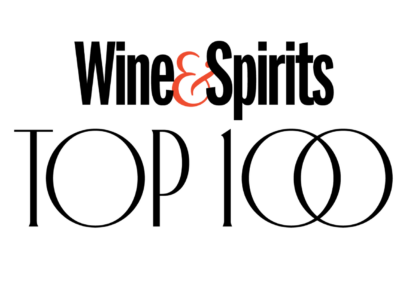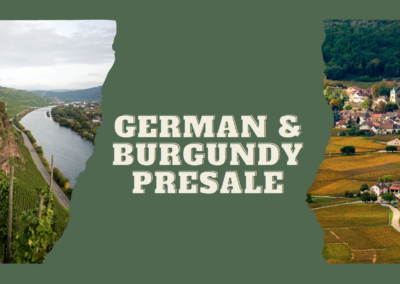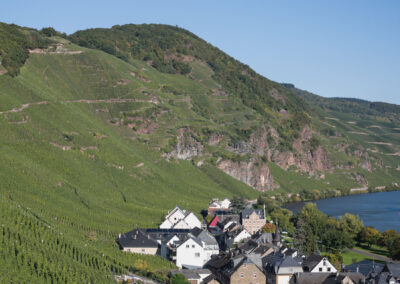The origins of Burgundian winemaking history can be credited to the Romans, dating back to the 1st Century. In the Middle Ages, it was the Catholic Monks who firmly established the vineyards, which served the church and the Dukes of Burgundy. After the French Revolution, the vineyards were returned to the people. Ever since, vignerons have prided themselves on their deep attachment to the land – a connection that has developed and inspired growth in sustainable viticulture and winemaking.
Join Kirk Wille for a tour of Burgundy; explore the climats and villages of this world-class winegrowing region.
For all of us who love great wine, the vineyards of Burgundy are hallowed ground. I’ve hosted trips where guests have lept from the car to quite literally kiss the calcareous stones of Montrachet. My personal stone-licking habit started with the Riesling-bearing slate of the Mosel valley, but I also carry a deep reverence for the history and culture of “les climats de Bourgogne,” and for the profound vinous pleasures that they can produce. It is utterly without abashment that I bend the knee before the great sites of the Côte d’Or, especially one such as Clos de la Roche in Morey-Saint-Dénis, which was where, in the dank cellar of a minor producer, my true Burgundy education began nearly three decades ago.
Romantic adulation aside, the Côte d’Or is also a fascinating region to explore from a more practical, and truly down-to-earth, wine-lover’s point of view. It is a narrow and compact area along an east-facing slope that’s just over 30 miles from south to north, so you can cruise the extent of it by car in an hour. You will want to linger in certain villages and vineyards, however, to gain a more rooted appreciation for the region, its people, and its wines. But, with 1,247 defined climats in more than 30 villages, where to start? Our answer: use Bellene as your guide!
Between Domaine de Bellene (owned vineyards) and Maison Roche de Bellene (contracted vineyards), the wines that Nicolas Potel is making encompass more than 80 appellations in greater Burgundy, primarily in the Côte d’Or. Touring the Côte through his wines, either on the ground or at home, provides a clear and consistent winemaking lens through which you can see the nuanced differences between villages and climats that inspired all those generations of Benedictine and Cistercian monks to expend so much effort in cataloging them.

You can start at the southern end of the Côte de Beaune, where Chardonnay is dominant, in the charming and welcoming village of Santenay. Less known than its world-famous neighbors, Chassagne-Montrachet, Puligny-Montrachet, and Meursault, there are nevertheless some excellent wines being made in Santenay these days. One of them is Domaine de Bellene’s “Les Charmes Dessus,” a villages site that abuts the Clos Rousseau premier cru. From a flatter area at the base of the slope, it does not have the power, density, or intense mineral cut of the hyphenated Montrachets, but it is a solidly gorgeous example of Chardonnay from red clay soil that’s punctuated with white limestone pebbles. I recently opened the 2012 vintage and it was superbly aromatic and balanced, with a nice touch of maturity beginning to emerge. Santenay also has the advantage of being far more affordable than wines from its celebrated neighbors.
The Bellene Burgundy Tour continues through those highly prized Chardonnay appellations in Chassagne, Puligny, and Meursault, even venturing up into the side valley of Saint-Aubin, and then onto the red wines of Volnay. But the next full stop is in the city of Beaune, the cultural epicenter of the Côte d’Or and home of Domaine de Bellene. Beautiful and history-rich, it is surprisingly easy to get lost in the narrow, labyrinthine streets of the small, walled centre of Beaune. But you needn’t despair because there are abundant sights, shops, wine bars, cafés, and restaurants to sustain you in your wanderings.
Once you breach the circular perimeter wall, however, and make your way east toward the slope of vines, you will find the true historical treasures of Beaune. There are no grand crus here, but an astonishing number of excellent premier cru sites – 42 to be exact. Nico feels that many of the best of these are woefully underappreciated around the world, and is working to bring them to greater prominence. One prime example is “Les Grèves,” where Domaine de Bellene owns a parcel of extremely old vines, perhaps the oldest in all of the appellation, planted in 1904. Locally, this site is known to produce some of the richest, most structured, and long-lived wines of Beaune. The Bellene bottling certainly lives up to that reputation, with its old-vine depth, concentration, and complex aromatics.

Continuing north, we come to Savigny-lès-Beaune, where Maison Roche de Bellene is based. The Domaine also owns several parcels here, producing a new class of red and white wines from an appellation that was formerly regarded as only capable of a rather rustic style. In the right hands, however, these vineyards on the valley floor beneath the iconic Hill of Corton can yield wines of substance and grace. The Domaine’s Savigny-lès-Beaune blanc and Vieilles Vignes rouge show the exhuberance and earthy suavity that are possible in this supposedly “sauvage” appellation.
Aloxe-Corton, source of the Maison’s Corton-Charlemagne and Corton rouge grand crus, marks the northern limit of the Côtes de Beaune. After that, we are into the Côtes de Nuits and on our way to the very important wine village of Nuits-Saint-Georges, the area’s namesake. The Domaine produces an exceptional old-vine bottling here, from three villages parcels on the north side of town, adjacent to Vosne-Romanée. As is the goal with all of his wines, here Nico captures the signature aspects of this part of the appellation: dark fruit, full-bodied texture, and muscular structure.
A few more steps north and we are into the justly renowned village of Vosne-Romanée. It is here that some of the most revered grand crus of Burgundy are found, as well as a host of cherished premier crus. The wines of Vosne-Romanée are highly prized for their unique ability to combine muscular power with supreme elegance and nobility. At their best, they are the iron-clad fist of Philip the Bold swathed in a velvet glove.

In this exalted ground, Domaine de Bellene has an old-vine parcel (planted 1937) in the exceptional premier cru, “Les Suchots,” that lies directly adjacent to Romanée Saint-Vivant. Black-fruited, spicy and taut in structure, this wine’s supple elegance and sappy length need time in the bottle to emerge. It’s a wine to lay down for a decade or more and ponder in its maturity.
The Domaine’s holdings end in Vosne-Romanée, but the Maison produces a further range of wines from the roster of famous villages that follow as you continue north: Echézeaux, Vougeot, Chambolle-Musigny, and Morey-Saint-Dénis (back to Clos de la Roche!). The Bellene Burgundy Tour ends in Gevery-Chambertin, a village overflowing with grand cru vineyards that for many enthusiasts rivals Vosne-Romanée in quality and stature. Here, Nico makes a classic Gevrey-Chambertin villages bottling that deftly embodies the bold sophistication of the appellation. In most vintages, there is also a limited bottling from the premier cru “Champeaux,” which occupies an up-slope spot on the northern edge of the picturesque Côtes St-Jacques hillside. And, since this village boasts more grand cru vineyards than any other village (217 acres in all), several Maison grand crus are produced each year, including Charmes-Chambertin and the big daddy of all, Chambertin itself.
Touring Burgundy is an endlessly fascinating enterprise, as there is so much to learn about the multitude of villages and appellations. But, as with any wine region, you can’t fully grasp its spiritual ethos and geographical complexity until you travel there and dig your hands into the heart and soil of the culture. You don’t have to resort to actual dirt kissing, but spending time there in real life will make you love it even more! We hope you can make it over there sometime soon. You are always most welcome to pay a visit to Domaine de Bellene.

Be sure to check out our Domaine de Bellene and Maison Roche de Bellene estate profiles for more information and to see the complete range of wines we offer in the U.S.




